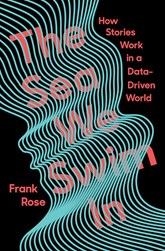The Sea We Swim In: How Stories Work in a Data-Driven World
June 23, 2021
We must be deliberate about choosing what stories we tell, and what stories we believe, because they are the waters we swim in—the way we construct our own realities.
 The Sea We Swim In: How Stories Work in a Data-Driven World by Frank Rose, W.W. Norton & Company
The Sea We Swim In: How Stories Work in a Data-Driven World by Frank Rose, W.W. Norton & Company
We are a species made of stories. We like to believe that we find the truth in reason, but we are convinced by, and shape our own realities around, stories. As we’ve witnessed in the rise of conspiracy theories around the coronavirus and presidential election over the past year, science and rationality can be trumped by powerfully told, emotionally appealing, and endlessly repeated narratives that are contrary to verifiable facts. We can say that such narratives are divorced from reality, but as Frank Rose writes in The Sea We Swim In, “reality is a construct, and narrative is the chief means of construction.” So, even if we want to suggest that such narratives deny reality, we can’t deny the fact that they define reality for many.
That has always felt a little exhausting to me, but also, essentially, hopeful. I don’t want to believe that people need to be convinced of the truth, but it is also assuring to know that they can be, that the narrative can be changed, the script flipped. As Rose writes:
Stories have been weaponized throughout history. Only by understanding how they work, how they can prey on emotions, can we create stories to counter them.
Rose discusses how, growing up in Virginia, he didn’t question the Confederate monuments that surrounded him. It wasn’t until activists started protesting them that he saw them for what they were, “part of a large-scale effort to rewrite the story of the Civil War” as a noble but lost cause to preserve a way of life—a way of life that devalued, debased, and enslaved the lives of so many. It feels a little jarring to go from such fundamental truths to discussing business cases, such as how Warby Parker and Harry’s took on monopolies in eyeglasses and razors, respectively, by fashioning great stories centered around value and values, lifestyle, and—most consequentially—stories. But we should remember that the enslavement of human beings in America was, at its base, a business decision. The lie of racial superiority was a story constructed to justify it, reconstructed to end Reconstruction and enact Jim Crow, and we are living with the ramifications of that story and its evil iterations to this very day. So, as with racism itself, it’s important to realize that:
If we live in a sea of stories, then narrative thinking means being aware of the sea we swim in. It means realizing that stories constitute a distinct mode of thought, one that plays such a central role in human experience that anyone who wants to sell something, communicate ideas, motivate people, or change their minds should understand how they work.
This is especially important in our current media and information environment, where we all interact with and contribute to the stories being told, where the biggest media companies in the world are social, industrial in scale, addictive in nature, and it is as easy to construct a shared reality that is completely fake as it is to find the truth. We must be even more deliberate about choosing what stories we tell, and what stories we believe, because they are the waters we swim in, and they can easily drown us in disinformation, demagoguery, and deceit. On the flip side, it gives us agency, and an ability to flip the script and build better stories, better businesses, and a better society. It’s our choice. Hopefully we are thoughtful in our choosing.



